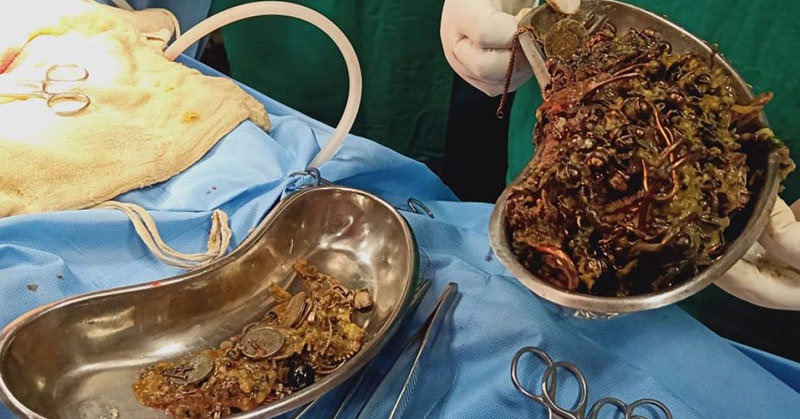Runi Khatun, 22, suffered from extreme abdominal pain before being rushed to Rampurhat Government Medical College and Hospital. She couldn’t hold down any food, and her body was so emaciated, the doctors couldn’t operate immediately.
Once they stabilized her, they took her into surgery and found over $64,000 worth of jewelry and coins in her stomach.
The Baffling Operation
When the Khatun from West Bengal, India, first arrived at the hospital, she was weak and dangerously thin. Medical personnel took X-rays to learn what was wrong with her. These tests picked up metal in her stomach, but the hoard wasn’t discovered until the surgery.
Dr. Siddhartha Biswas, head of the surgery department, led the operation that found 1.6 kg of metal jewelry, money, a watch, and other trinkets in the woman’s stomach. It was clear why her digestive system couldn’t hold any proper food.
“The patient looked weak and emaciated at the time when she was admitted to the hospital,” said Dr. Biswas. “Her albumin and hemoglobin count were so low that we could not perform an operation soon.”
“Her condition was so critical that she required at least five bottles of blood. She could not even intake food physically so we had to administer Total Parenteral Nutrition (TPN) to artificially inject food through her mouth.” [1]
The stabilizing process took a little less than a week. According to Dr. Biswas: “If we had operated on her earlier, she wouldn’t have survived.”
The operation took one hour and 15 minutes to complete. Most of that time was used to remove 69 chains, 80 earrings, 11 nose rings, eight lockets, five anklets, 46 coins, and one watch from her stomach. [2]
Why was the Jewelry in Her Stomach?
The woman is currently undergoing psychiatric treatment. Her family suspects she had taken the trinkets from her brother’s costume jewelry shop.
A family member had noticed items disappearing from the display cases and at home, but when the 22-year-old woman was confronted about it, she cried and denied everything.
Khatun’s mother admitted her daughter was not well for the past two months. She tried to keep a close eye on her, but Khatun still managed to swallow the metal objects.
“Before admitting her at the Rampurhat Government Hospital,” said her mother, “we had taken her to various private doctors and she was on medication without any result.”
Fortunately, Dr. Biswas declared the patient to be stable and will be discharged from the hospital soon. [3]
Pica: An Unusual Eating Disorder
Experts believe Khatun is suffering from pica, an eating disorder that involves eating non-food items without nutritional value.
There is no proper test for pica. The diagnosis is made from the patients’ clinical history and tests for anemia, intestinal blockages, and toxic side effects of the items consumed (for instance, lead in paint, or parasites in dirt.)
Symptoms of Pica include:
- Persistently eating non-food substances for at least a month.
- Ingesting substances not culturally supported or socially normal, (for example, some cultures eat clay for medicinal purposes.)
- This eating habit is developmentally inappropriate. (Therefore, children under two—for whom it is normal to mouth non-food items—cannot be diagnosed with pica.)
- Typical non-food items include:
- Paper
- Soap
- Hair
- Cloth
- String
- Wool
- Soil
- Talcum powder
- Chalk
- Gum
- Paint
- Metal
- Pebbles
- Charcoal
- Clay
- Ice
- Ash
- Starch [4]
Pica usually comes with other mental health disorders with impaired functioning, such as autism, schizophrenia, and intellectual disability. It might also accompany trichotillomania (hair-pulling disorder) and excoriation (skin-picking) disorder.
Pica can affect any age, ethnicity, or gender, but it is more likely to occur in developing countries.
Sometimes, pica is a sign of anemia or malnutrition. Treating this nutritional deficiency with medications and vitamins usually resolves the eating issues. If the symptoms are not caused by a deficiency, behavioral interventions are available for further treatment. In the autism community, scientists developed a method of intervention that includes directing the patient’s attention away from the craved item and rewarding them for throwing away the item. [5]
The Health Consequences of Eating Disorders
Eating disorders are potentially life-threatening and affect patients’ emotional and mental health. They can affect every system in the body, including the cardiovascular system, the gastrointestinal system, the neurological system, and the endocrine (hormone) system. They can cause dry skin, hair loss, anemia, and a lowered immune system. The body might grow lanugo, fine, downy hair to conserve warmth.
Patients who suffer from eating disorders, especially anorexia nervosa and bulimia nervosa, have an increased mortality rate from starvation, substance abuse, and suicide. Researchers have also found an increase in death from ‘natural causes’ like cancer. The earlier a person with an eating disorder seeks help, the more likely they will achieve physical and emotional recovery. [6]
Sources
- Sophie Law. Doctors remove 3lbs of coins and jewellery from compulsive eater’s stomach https://www.dailymail.co.uk/news/article-7284945/Doctors-remove-53k-worth-coins-jewellery-womans-stomach.html July 25, 2019
- Abigail O’Leary. Doctors remove hundreds of coins and jewellery worth £53k from woman’s stomach https://www.mirror.co.uk/news/uk-news/doctors-remove-hundreds-coins-jewellery-18780164 July 26, 2019
- Gemma Mullin. Baffled docs remove £53k worth of jewellery and coins from woman’s stomach https://www.thesun.co.uk/news/9584230/doctors-remove-53k-jewellery-coins-stomach/ July 25, 2019
- Gretchen Holm. What Causes Pica? https://www.healthline.com/symptom/pica February 29, 2016
- National Eating Disorder Association. Pica https://www.nationaleatingdisorders.org/learn/by-eating-disorder/other/pica
- National Eating Disorder Association. Health Consequences of Eating Disorders. https://www.nationaleatingdisorders.org/health-consequences

